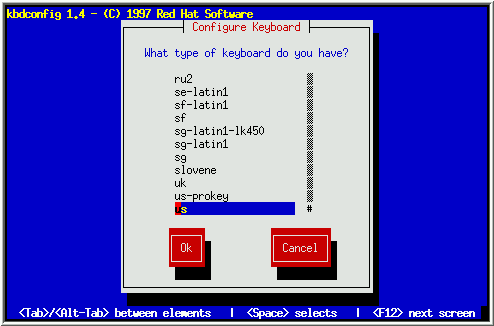
After booting, the installation program begins by asking if you are using a color monitor (see Figure 6). Yes is the default -- you should see a cursor or highlight next to the Yes button. If you don't see a cursor or highlight press [Tab] once to select No, and then [Enter] to proceed.

Next, the installation program displays a welcome message. Press [Enter] to begin the installation. If you wish to abort the installation process at this time, simply eject the boot diskette now and reboot your machine.
After the welcome dialog, the installation program gives you an opportunity to select a keyboard type (see Figure 7). Using the [\uparrow] and [\downarrow] keys, select the appropriate keyboard type for your Red Hat Linux system. Note the scroll bar to the right of the keyboard types -- it indicates that there are more types than can be displayed at one time. You'll be seeing scroll bars like this throughout the installation program.
After selecting the appropriate keyboard type, press [Enter]; the keyboard type you select will be loaded automatically both for the remainder of the installation process and each time you boot your Red Hat Linux system. If you wish to change your keyboard type after you have booted your Red Hat Linux system, you may use the /usr/sbin/kbdconfig command.

Next, the installation program will probe your system to determine if your system requires PCMCIA (also known as PC Card) support. If a PCMCIA controller is found, you will asked to insert the supplemental diskette -- Select OK when you've done so.
The installation program will then display a progress bar as the supplemental diskette is loaded.
Please Note: If you are performing an installation in expert mode, you will be asked whether PCMCIA support is required. You must answer Yes if you are using a PCMCIA device for installation (for example, a PCMCIA ethernet card for installing via NFS, or a PCMCIA SCSI card for installing from a SCSI CD).